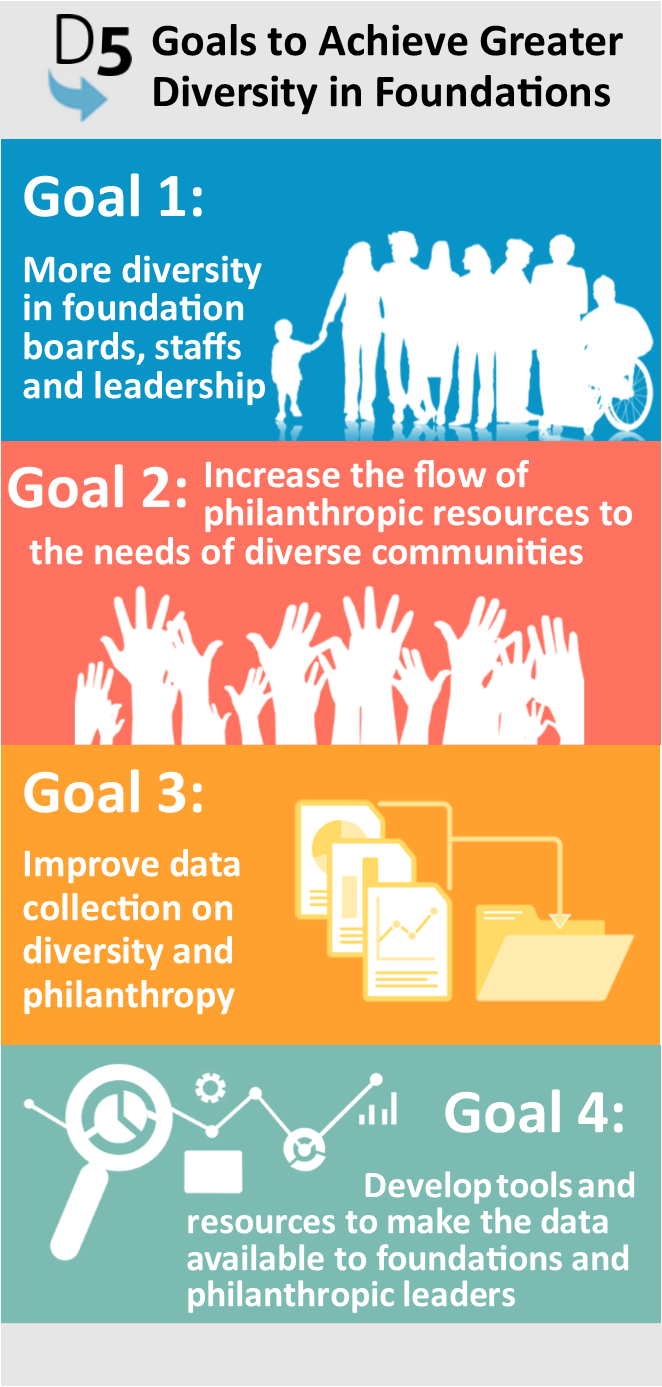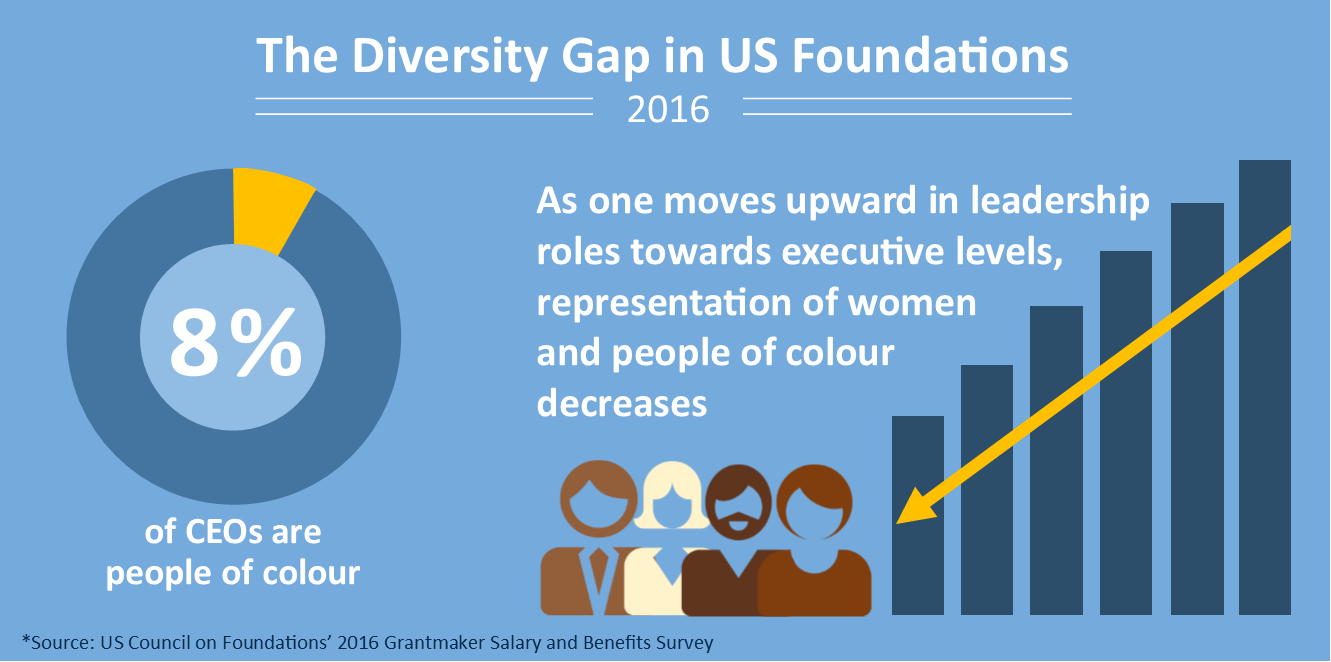Diversity, Equality, Inclusion – There’s a Long Way to Go
This article originally appeared in the September 2017 issue of Alliance Magazine.
In 2016, women represented over three-quarters of foundation staff in the US but among the largest grantmakers,fewer than half of foundation CEOs were women. In the same year, racial and ethnic minorities made up only 10 per cent of foundation CEOs. Given these statistics alongside current political and social discourse on race and inequality in the US, American philanthropy is increasingly focusing on the themes of diversity, equity and inclusion – known in a sector addicted to abbreviations as ‘DEI’.
The Business Case
The business case for DEI is fuelled by the sector’s quest to advance the common good. Talent diversity within foundations can create a ripple effect – shaping the lens through which the foundations view their grantees, thereby leading to greater cultural competence within the foundation and a better understanding of community needs, which in turn contributes to a more equitable grantmaking process.
In the US, philanthropy often addresses diversity, equity and inclusion as a collective – ‘DEI’ has become a buzzword – but it is important to view each of these elements individually. Diversity refers to the full range of human and/or organizational differences and similarities, from the personal (race/ethnicity, gender, age, sexual orientation, gender identity, physical ability) to the organizational (work experience and function, for example).
Equity relates to the fair utilization of organizational practices, policies and systems. When striving for equity, organizations must acknowledge and redress historical legacies and current inequities that result in differences in application of these systems.
Inclusion is the process of engaging and leveraging a diverse talent pool across a wide range of dimensions and welcoming them to contribute their whole selves to the achievement of equitable organizational goals.
An Emerging Consensus
 Over the last decade, the sector has examined the diversity of talent within foundations. The D5 Coalition, a collective of funders and advisors, produced several publications on the state of diversity, equity and inclusion between 2011 and 2016.
Over the last decade, the sector has examined the diversity of talent within foundations. The D5 Coalition, a collective of funders and advisors, produced several publications on the state of diversity, equity and inclusion between 2011 and 2016.
Overall, there is sector-wide consensus that more needs to be done because talent within the US philanthropic sector is still not reflective of the overall workforce or the communities served by philanthropy, with women over-represented at junior levels and people of colour under-represented across the board.
Several organizations in the US have programmes focusing on building philanthropy’s talent pipeline today. Career Pathways, the Council on Foundations’ flagship leadership development programme, was launched in 2009 to increase the diversity of candidates being considered for philanthropic leadership positions.
To date, 89 per cent of programme alumni have been promoted to senior/executive level appointments.
The ABFE (Association of Black Foundation Executives) Connecting Leaders Fellowship Programme has worked with 111 participants since the programme’s inception in 2005, to strengthen the leadership capacity of foundation staff, donors and trustees committed to assisting Black communities through philanthropy.
The Minnesota Council on Foundations has also offered the Ron McKinley Philanthropic Fellowship since 2014, preparing individuals from underrepresented communities for careers in philanthropy. Alongside work on the sector’s talent pool, US foundations are also integrating DEI themes in their approach to serving communities.
For example, the WK Kellogg Foundation launched a Day of Racial Healing earlier this year as part of its ongoing project to promote Truth, Racial Healing, and Transformation, which aims to help heal wounds created by racial, ethnic and religious bias in the US.
Other foundations, including the Ford Foundation and The San Francisco Foundation are focused on advancing equity through their grantmaking efforts.
Looking for Resemblances?
Unfortunately, recent DEI efforts have not yet moved the needle on representation within US philanthropy.
Perhaps this is because barriers to greater diversity within the talent pipeline may have more to do with the biases – conscious and unconscious – of those deciding who to hire. If organizational leaders only see genius in those who remind them of themselves, diversifying the pool of future leaders will remain elusive.
 Achieving greater diversity for American philanthropy will require an intentional and integrated approach.
Achieving greater diversity for American philanthropy will require an intentional and integrated approach.
Minimizing bias, recognizing talent in all forms, and developing a more diverse pool of philanthropic leaders alongside programmatic DEI activities will collectively contribute to a more diverse, equitable and inclusive sector.
The key to achieving this goal lies not in any one of these approaches, but in all of them.
Floyd Mills is vice president of diversity, equity and inclusion at the Council on Foundations. Email floyd.mills@cof.org.
Natalie Ross is senior director for global philanthropy and partnerships at the Council on Foundations. Email natalie.Ross@cof.org.
Key facts
US foundations: Age, Gender, Racial Gaps Remain
The 2016 Council on Foundations Grantmaker Salary and Benefits report identifies several key issues for the US philanthropic sector, including an age and gender gap as well as a lack of diversity among CEOs. More than a third of full-time employees are aged 50 to 64, with 6 per cent over the retirement age, while those under 30 represent only 11 per cent. Additionally, racial and ethnic minorities only comprise 10 per cent of US foundation CEOs. Women made up approximately three-quarters of staff, but just over half of CEOs.
D5 coalition
The D5, or Diversity 5, programme, which ran until 2016, focused on striving to meet four major goals: more diversity in foundation boards, staffs and leadership; increasing the flow of philanthropic resources to the needs of diverse communities; improving the data collection on diversity and philanthropy; and developing tools and resources to make them available to foundations and philanthropic leaders. Stephen Heintz, CEO of the Rockefeller Brothers Fund, which backed the effort said: We need to make sure that (foundations are) broadly representative of society and the communities they serve.
Career Pathways Programme
Over the last five years, the percentage of CEOs of colour has remained the same at 8 per cent. The Council on Foundations Career Pathways Programme seeks to increase the amount of candidates from diverse backgrounds who are considered, appointed and retained in senior executive philanthropic leadership positions. 24 philanthropic leaders are participating in the 2017 cohort, providing virtual and in-person learning practices, networking events, and career training.


